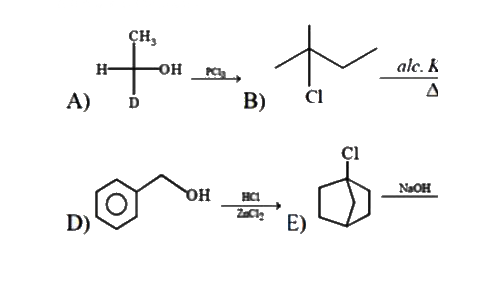Substitution reaction is a characteristic of
alkene
carbon monoxide
alkyne
paraffin
The correct Answer is:D
Step-by-Step Text Solution:
1. Understanding Substitution Reactions: A substitution reaction is a type of chemical reaction where one atom or group of atoms in a molecule is replaced by another atom or group of atoms. This is a key characteristic of certain types of hydrocarbons.
2. Identifying Hydrocarbon Types:
- Alkenes: These are hydrocarbons that contain at least one carbon-carbon double bond (C=C).
- Alkynes: These contain at least one carbon-carbon triple bond (C≡C).
- Alkanes (Paraffins): These are saturated hydrocarbons with only single bonds (C-C).
- Carbon Monoxide (CO): This is a simple molecule consisting of one carbon and one oxygen atom, and it does not participate in substitution reactions.
3. Analyzing the Options:
- Option A (Alkene): Alkenes typically undergo addition reactions rather than substitution reactions due to the presence of double bonds.
- Option B (Carbon Monoxide): This is not a hydrocarbon and does not undergo substitution reactions.
- Option C (Alkyne): Alkynes also primarily undergo addition reactions due to their triple bonds.
- Option D (Paraffin/Alkane): Alkanes are known for undergoing substitution reactions, particularly when reacting with halogens in the presence of UV light.
4. Example of Substitution Reaction:
- Consider ethane (CH3CH3). When ethane reacts with chlorine (Cl2) in the presence of UV light, one hydrogen atom is replaced by a chlorine atom, resulting in chloroethane (CH3CH2Cl) and hydrochloric acid (HCl). This exemplifies a substitution reaction.
5. Conclusion: Based on the analysis of the options and the characteristics of the hydrocarbons, the correct answer is Option D (Paraffin/Alkane), as substitution reactions are characteristic of alkanes.
- Alkenes: These are hydrocarbons that contain at least one carbon-carbon double bond (C=C).
- Alkynes: These contain at least one carbon-carbon triple bond (C≡C).
- Alkanes (Paraffins): These are saturated hydrocarbons with only single bonds (C-C).
- Carbon Monoxide (CO): This is a simple molecule consisting of one carbon and one oxygen atom, and it does not participate in substitution reactions.
- Option A (Alkene): Alkenes typically undergo addition reactions rather than substitution reactions due to the presence of double bonds.
- Option B (Carbon Monoxide): This is not a hydrocarbon and does not undergo substitution reactions.
- Option C (Alkyne): Alkynes also primarily undergo addition reactions due to their triple bonds.
- Option D (Paraffin/Alkane): Alkanes are known for undergoing substitution reactions, particularly when reacting with halogens in the presence of UV light.
- Consider ethane (CH3CH3). When ethane reacts with chlorine (Cl2) in the presence of UV light, one hydrogen atom is replaced by a chlorine atom, resulting in chloroethane (CH3CH2Cl) and hydrochloric acid (HCl). This exemplifies a substitution reaction.
Topper's Solved these Questions
- DIFFERENT CHEMICAL REACTIONS BOOK - ARIHANT PUBLICATION JHARKHANDCHAPTER - DIFFERENT CHEMICAL REACTIONS EXERCISE - EXAM BOOSTER FOR CRACKING EXAM
45 Videos
- CONCEPT OF ATOMIC MOLECULAR AND EQUIVALENT MASSESBOOK - ARIHANT PUBLICATION JHARKHANDCHAPTER - CONCEPT OF ATOMIC MOLECULAR AND EQUIVALENT MASSESEXERCISE - EXAM BOOSTER FOR CRACKING EXAM
66 Videos
- ELECTROCHEMISTRY, ACIDS , BASES , SALT AND HYDROLYSIS BOOK - ARIHANT PUBLICATION JHARKHANDCHAPTER - ELECTROCHEMISTRY, ACIDS , BASES , SALT AND HYDROLYSIS EXERCISE - EXAM BOOSTER FOR CRACKING EXAM
78 Videos
Similar Questions
Knowledge Check
HVZ reaction is characteristic reaction of
Aα−H atomBβ−H atomCγ−H atomDδ−H atomAromatic electrophilic substitution reaction that is reversible is
AnitrationBchlorinationCsulphonationDalkylation
Substitution reaction
View SolutionNucleophilic substitution reaction in Haloarenes
View SolutionElectrophilic substitution reaction in Haloarenes
View SolutionWhat are substitution reactions? Give two examples of substitution reactions of benzene.
View SolutionProperties of haloalkanes:-substitution reaction || elimination reaction || reaction with metals || properties of haloarenes-electrophilic substitution || SNAR and benzyne
View SolutionIdentify number of nucleophilic substitution reactions in the given reactions?

View Solution
